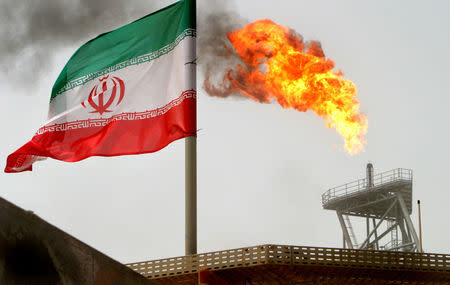Oil up on Iran sanctions but set for weekly decline
By Jessica Resnick-Ault
NEW YORK (Reuters) - Oil prices rose more than 1 percent on Friday as U.S. sanctions against Iran looked set to tighten supply, but futures remained lower for the week as investors worried that global trade disputes could slow economic growth and hurt demand for energy.
Benchmark Brent crude oil <LCOc1> was up 90 cents at $72.96 a barrel by 1:56 EDT (1756 GMT). U.S. light crude <CLc1> was 78 cents higher at $67.59 a barrel.
Brent remained on course to fall 0.3 percent in the week, while U.S. crude was on track to drop 1.1 percent, following a sell-off on Wednesday.
"It's not surprising to see a bit of a bounce back here," said Tariq Zahir. But he said prices would remain under pressure as U.S. gasoline demand slows going into the fall and refiners shut for maintenance, pushing more crude into storage.
"I think it now comes down to the point of what we see in demand numbers."
U.S. crude supplies fell less than expected in the latest week, and data released on Friday showed U.S. energy companies this week added the most oil rigs since May.
Drillers added 10 oil rigs in the week to Aug. 10, bringing the total count to 869, the most since March 2015, General Electric Co's <GE.N> Baker Hughes energy services firm said in its closely followed report on Friday. <RIG-OL-USA-BHI> [RIG/U]
Escalating trade disputes have dimmed the outlook for economic growth and boosted the dollar, making oil more expensive for consumers using other currencies.
Currencies of major emerging economies including China, India and Turkey have slumped.
Despite these worries, prices got a boost from U.S. sanctions against Iran, which from November will affect oil exports.
Although the European Union, China and India oppose sanctions, many are expected to bow to U.S. pressure.
Analysts expect Iranian crude exports to fall by between 500,000 and 1.3 million barrels per day, with buyers in Japan, South Korea and India already dialling back orders.
The reduction will depend on whether buyers of Iranian oil receive waivers that would allow some imports.
The International Energy Agency said on Friday the oil market could see more turbulence later this year.
"The recent cooling down of the market, with short-term supply tensions easing, currently lower prices, and lower demand growth might not last," the IEA said in a monthly report.
"As oil sanctions against Iran take effect, perhaps in combination with production problems elsewhere, maintaining global supply might be very challenging."
Investors are keeping a wary eye on the trade dispute between Washington and Beijing.
In the latest round of levies, China said it would impose additional tariffs of 25 percent on $16 billion worth of U.S. imports.
Although crude was removed from the list, replaced by refined products and liquefied petroleum gas, analysts say Chinese imports of U.S. crude will fall significantly.
(Additional Reporting by Christopher Johnson in London and Henning Gloystein in Singapore; Editing by Dale Hudson and David Gregorio)

 Yahoo Finance
Yahoo Finance 

